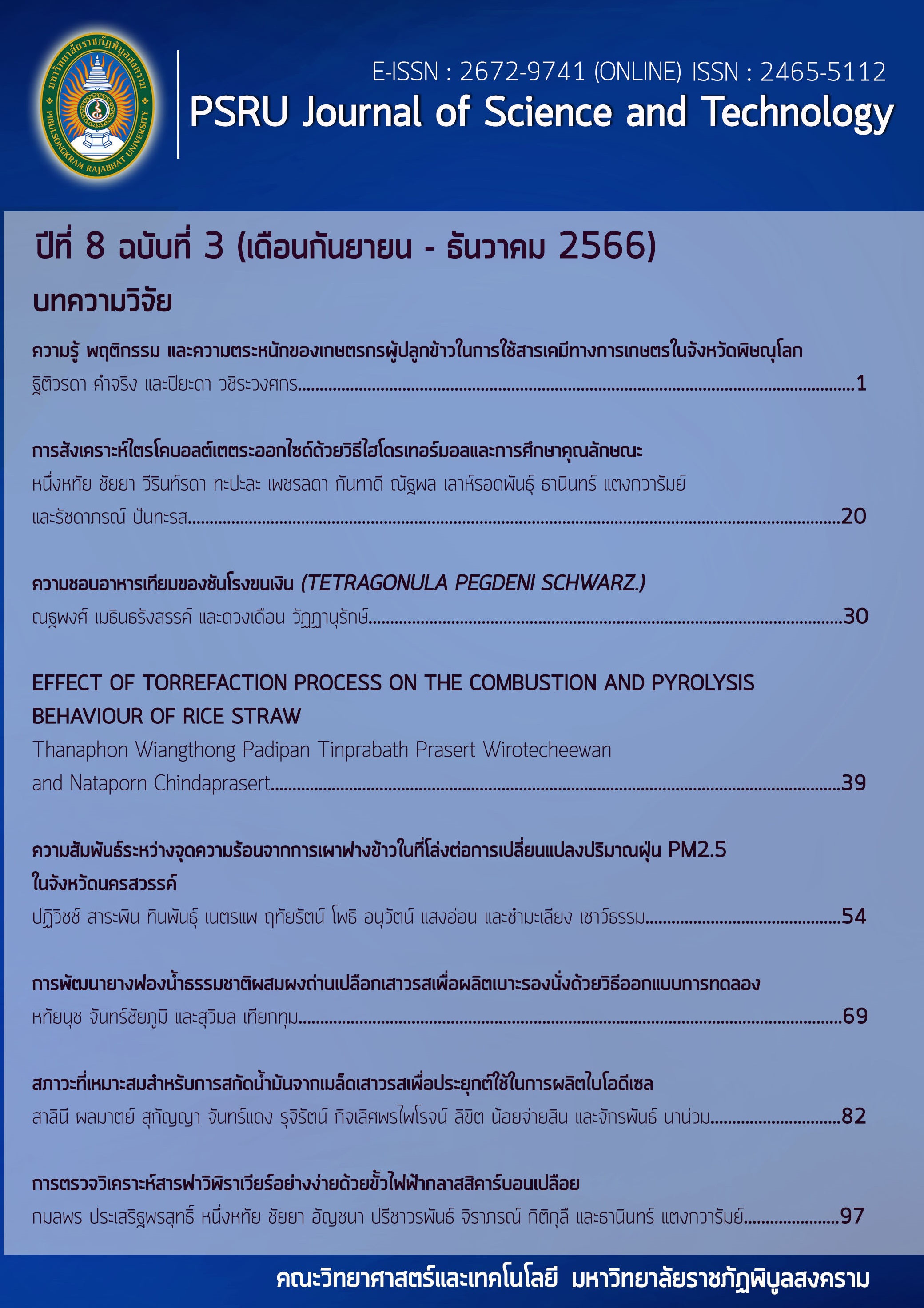THE RELATIONSHIP BETWEEN HOTSPOTS FROM OPEN FIELD BURNING OF RICE STRAW AND PM2.5 CHANGE IN NAKHONSAWAN PROVINCE
Keywords:
PM2.5, Hotspot, Open field burning, Rice strawAbstract
The purpose of this research was to investigate fire hotspots by using MODIS (Moderate Resolution Imaging Spectroradiometer) satellite sensors carried on the Terra and Aqua satellite and use them to assess open field burning influencing fine particulate matters with a diameter less than 2.5 micrometers (PM 2.5) in Nakhon Sawan Province area. During the production year 2020 /2021, PM2.5 samples were collected daily for 24 hours at the Air Quality Monitoring Station in Pak Nam Pho sub-district, Mueang Nakhon Sawan district, Nakhon Sawan. The results showed that if all rice straw is burned in the production year 2020/2021, the amounts of PM 2.5 from in-season rice and off-season rice were approximately 10,075.86 kg and 1,461.46 kg, respectively. The highest hotspots in Nakhon Sawan province areas were observed in December, January, and February, respectively. The districts most vulnerable to burning in the agricultural areas were Nong Bua, Tha Tako and Phaisali. In addition, correlation analysis showed that hotspot numbers that appeared were correlated with PM2.5 levels in the ambient air. However, the study results could potentially be utilized for supporting information for establishing guidelines for effectively, rapidly and efficiently preventing and dealing with PM2.5 particulate concerns and burning in the paddy fields of Nakhon Sawan Province and Lower Northern Provincial Cluster.
References
เกวลิน อินลวง, ชาคริต โชติอมรศักดิ์, วนิสา สุรพิพิธ, และ Ronald Macatangay. (2566). ความสัมพันธ์ของจุดความร้อนในพื้นที่ภาคเหนือตอนบนของประเทศไทยและพื้นที่โดยรอบต่อค่าความเข้มข้น PM 2.5: กรณีศึกษาช่วงฤดูหมอกควัน ปี พ.ศ. 2562. วารสารวิชาการพระจอมเกล้าพระนครเหนือ, 33(2), 588-602.
เข้มแข็ง ยุติธรรมดำรง. (2661). การติดตามจุดความร้อนจากการเผาเศษวัสดุทางการเกษตรเพื่อดำเนินการลดผลกระทบตามมาตรการแก้ไขปัญหาหมอกและควันไปในประเทศไทย. กรุงเทพฯ: วิทยาลัยป้องกันราชอาณาจักร.
เจน ชาญณรงค์. (2565). องค์ความรู้ไฟป่าและการเผาในที่โล่ง. กรุงเทพฯ: สมาคมวิศวกรรมสิ่งแวดล้อมแห่งประเทศไทย, ศูนย์วิชาการเพื่อขับเคลื่อนการป้องกันและแก้ไขปัญหามลพิษทางอากาศ (ศวอ).
พงศ์ธร เพียรพิทักษ์. (2564). การจัดการเศษวัสดุทางการเกษตรเพื่อลดการปลดปล่อยก๊าซคาร์บอนไดออกไซด์และสารก่อมลพิษทางอากาศในพื้นที่เกษตรกรรม 9 จังหวัด. กรุงเทพฯ: กรมพัฒนาที่ดิน, กองวิจัยและพัฒนาจัดการที่ดิน.
สำนักงานจังหวัดนครสวรรค์. (2564). ข้อมูลสำคัญจังหวัดนครสวรรค์ ประจำปี 2564. นครสวรรค์: สำนักงานจังหวัดนครสวรรค์, กลุ่มงานยุทธศาสตร์และข้อมูลเพื่อการพัฒนาจังหวัดนครสวรรค์.
สำนักงานเกษตรจังหวัดนครสวรรค์. (2566). แผนยุทธศาสตร์การพัฒนาข้าวอย่างยั่งยืน จังหวัดนครสวรรค์ พ.ศ. 2566–2570. นครสวรรค์: กระทรวงเกษตรและสหกรณ์, กรมส่งเสริมการเกษตร.
สำนักงานพัฒนาเทคโนโลยีอวกาศและภูมิสารสนเทศ. (2561). สถานการณ์ไฟป่าจากภาพถ่ายดาวเทียม. สืบค้นเมื่อ 2 พฤศจิกายน 2565, จาก https://fire.gistda.or.th.
หน่วยวิจัยเพื่อการจัดการพลังงานและเศรษฐนิเวศ. (2565). โครงการวิจัย เรื่อง การเฝ้าระวังและเตือนภัยปัญหาหมอกควันโดยเครื่องตรวจวัดคุณภาพอากาศระบบเซ็นเซอร์ Dust Boy ในประเทศไทย ระยะที่ 3. สถาบันวิจัยวิทยาศาสตร์และเทคโนโลยี. เชียงใหม่: มหาวิทยาลัยเชียงใหม่.
Adeleke, A., Apidechkul, T., Kanthawee, P., Suma, Y., & Wongnuch, P. (2017). Contributing Factors and Impacts of Open Burning in Thailand: Perspectives from Farmers in Chiang Rai Province, Thailand. Journal of Health Research, 31(2), 159-167.
He, G., Liu, T., & Zhou, M. (2019). Straw Burning, PM 2.5 and Death: Evidence from China. Emerging Markets Economics: Environmental & Social Aspects eJournal, 2019-66.
Junpen, A., Pansuk, J., Kamnoet, O., Cheewaphongphan, P., & Garivait, S. (2018). Emission of Air Pollutants from Rice Residue Open Burning in Thailand, 2018. Atmosphere, 9, 449.
Tansey, K., Beston, J., Hoscilo, A., Page, S.E., & Paredes Herna´ndez, C.U. (2008). Relationship between MODIS fire hot spot count and burned area in a degraded tropical peat swamp forest in Central Kalimantan, Indonesia. Journal of Geophysical Research Atmospheres, 13, D23112.
Thepnuan, D., & Chantara, S. (2566). Characterization of PM2.5–bound Polycyclic Aromatic Hydrocarbons in Chiang Mai, Thailand during Biomass Open Burning Period of 2016. Applied Environmental Research, 42(3), 11-24.
Tianwei, W., Ke, M., Peihong, F., & Wei, H. (2022). Crop residual burning correlations with major air pollutants in mainland China. Frontiers in Environmental Science, 10, 1002610.
Tipayarom, D., & Oanh, N.T.K. (2007). Effects from Open Rice Straw Burning Emission on Air Quality in
the Bangkok Metropolitan Region. Science Asia, 33, 339-345.
Downloads
Published
Versions
- 2024-05-29 (2)
- 2023-12-20 (1)
How to Cite
Issue
Section
License
Copyright (c) 2023 PSRU Journal of Science and Technology

This work is licensed under a Creative Commons Attribution-NonCommercial-NoDerivatives 4.0 International License.
กองบรรณาธิการขอสงวนสิทธิ์ในการปรับปรุงแก้ไขตัวอักษรและคำสะกดต่างๆ ที่ไม่ถูกต้อง และต้นฉบับที่ได้รับการตีพิมพ์ในวารสาร PSRU Journal of Science and Technology ถือเป็นกรรมสิทธิ์ของคณะวิทยาศาสตร์และเทคโนโลยี มหาวิทยาลัยราชภัฏพิบูลสงคราม และ
ผลการพิจารณาคัดเลือกบทความตีพิมพ์ในวารสารให้ถือมติของกองบรรณาธิการเป็นที่สิ้นสุด






